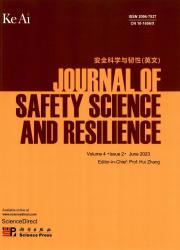Resilience in Cyber-Physical Infrastructures: R-KPI prioritization, framework development, and case study insights
IF 3.4
Q1 PUBLIC, ENVIRONMENTAL & OCCUPATIONAL HEALTH
引用次数: 0
Abstract
Critical infrastructures (CIs) embody cyber-physical-social systems (CPSSs) where physical entities are integrated with cyber components, shaping service delivery through end-user behavior. The seamless operation of CIs is vital for society, and the CPSS resilience relies on interdependencies with AI-integrated technologies. The complexity of the system, and the interconnections with other infrastructures, along with the socio-technical transition towards digitization raised the necessity of implementing Resilience Engineering. This motivates exploration of the scientific literature on resilience key performance indicators (R-KPIs) which support strategies for ensuring service continuity. Therefore, this article aims to identify R-KPIs for AI-integrated CIs and prioritize the extracted R-KPIs using a hybrid Multi-Criteria Decision-Making (MCDM) approach. The results show the importance of employing R-KPIs that measure risk probability, energy self-sufficiency level of the system under study, and performance indicators including functionality loss, recovery time, and minimum performance level after disturbance as the most effective R-KPIs in the domain of this study. After identifying and prioritizing the R-KPIs, a general framework is proposed to employ these R-KPIs in modeling the resilience of a CPS. Finally, a case study demonstrates the implementation of the framework and KPIs in a real-life scenario.
网络物理基础设施中的弹性:R-KPI优先级、框架开发和案例研究见解
关键基础设施(ci)体现了网络-物理-社会系统(cpss),其中物理实体与网络组件集成,通过最终用户行为塑造服务交付。ci的无缝运行对社会至关重要,CPSS的弹性依赖于与人工智能集成技术的相互依赖。系统的复杂性,与其他基础设施的相互联系,以及向数字化的社会技术转型,都提高了实施弹性工程的必要性。这激发了对弹性关键绩效指标(r - kpi)的科学文献的探索,这些指标支持确保服务连续性的战略。因此,本文旨在确定ai集成ci的r - kpi,并使用混合多标准决策(MCDM)方法对提取的r - kpi进行优先排序。结果表明,在本研究领域,采用衡量风险概率、所研究系统的能量自给水平以及包括功能损失、恢复时间和扰动后最低性能水平在内的性能指标的r - kpi是最有效的r - kpi。在确定r - kpi并对其进行优先级排序之后,提出了一个通用框架,以使用这些r - kpi对CPS的弹性进行建模。最后,案例研究演示了在现实场景中框架和kpi的实现。
本文章由计算机程序翻译,如有差异,请以英文原文为准。
求助全文
约1分钟内获得全文
求助全文
来源期刊

安全科学与韧性(英文)
Management Science and Operations Research, Safety, Risk, Reliability and Quality, Safety Research
CiteScore
8.70
自引率
0.00%
发文量
0
审稿时长
72 days
 求助内容:
求助内容: 应助结果提醒方式:
应助结果提醒方式:


